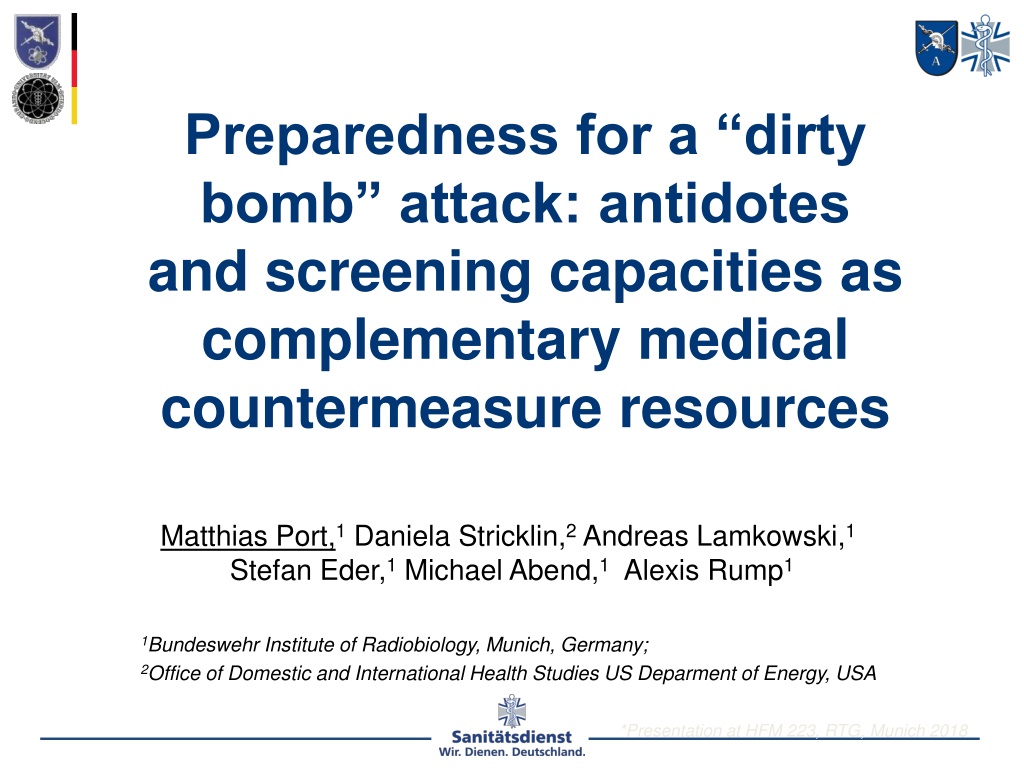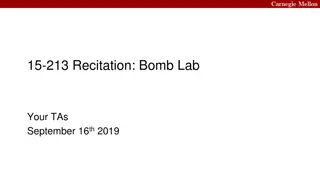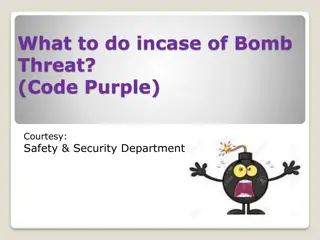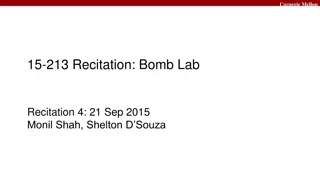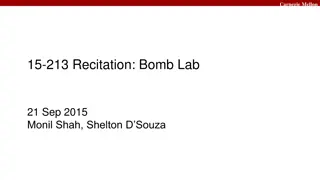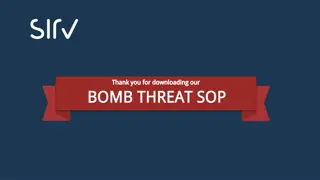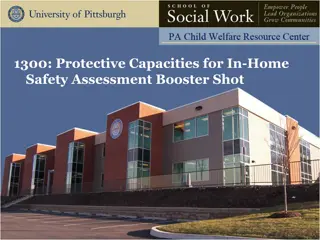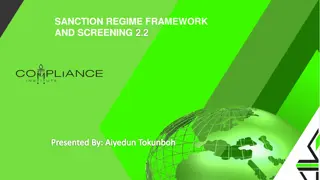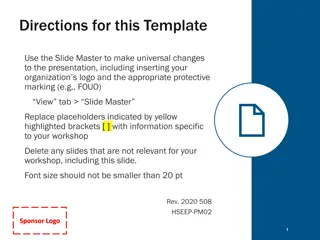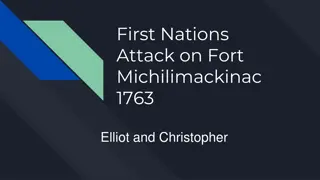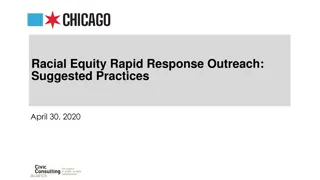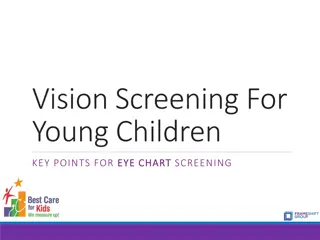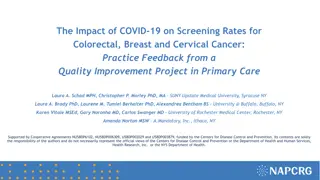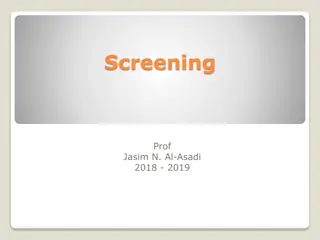Antidotes and Screening Capacities for Dirty Bomb Attack Preparedness
Explore the preparedness strategies for dealing with the aftermath of a dirty bomb attack, focusing on antidotes, screening capacities, and medical countermeasures. Learn about the types of injuries, national stockpiles for radiological and nuclear emergencies, and different approaches to decorporation strategies. Understand the importance of timely treatment initiation based on committed effective dose and internal dosimetry results.
Download Presentation

Please find below an Image/Link to download the presentation.
The content on the website is provided AS IS for your information and personal use only. It may not be sold, licensed, or shared on other websites without obtaining consent from the author. Download presentation by click this link. If you encounter any issues during the download, it is possible that the publisher has removed the file from their server.
E N D
Presentation Transcript
Preparedness for a dirty bomb attack: antidotes and screening capacities as complementary medical countermeasure resources Matthias Port,1Daniela Stricklin,2Andreas Lamkowski,1 Stefan Eder,1Michael Abend,1Alexis Rump1 1Bundeswehr Institute of Radiobiology, Munich, Germany; 2Office of Domestic and International Health Studies US Deparment of Energy, USA *Presentation at HFM 223, RTG, Munich 2018
Dirty bomb detonation Type of injuries Mechanical trauma / Blast Burns External irradiation Internal contamination
National Stockpiles for RN emergencies G-CSF Potassium iodide Ca(DTPA), Zn(DTPA) Prussian Blue (DMPS,DMSA)
Differences in decorporation strategies Middle of the Way Approach Precautionary Approach Urgent Approach Sources: GB, US, AUS, FRA authors Source: Defence R & D Canada Source: Autorit de Suret Nucl aire (FRA) Source: Bundeswehr Institute of Radiobiology Efficacy depends on the time of treatment start Indication of treatment depends on the committed effective dose: -< 20 mSv: no indication -20-200 mSv: case by case decision -> 200 mSv: indication Administration of iodide within 4-6 h after incorporation Otherwise no clear cut statements on when to start the treatment Indication for treatment basically depends on the committed effective dose Internal dosimetry (whole body counting, excretion measurements, calculation) takes time. Treatment may be started before results are available No standard. The decision when to start the treatment is taken case by case. In case of a suspicion of radionuclide(s) incorpo- ration, treatment is started after identification of the nuclides, a priori within 2 h The continuation of the treatment depends on the internal dosimetry results Treatment is started after the identification of the nuclide(s) as soon as possible. There is no clearly defined time limit The continuation of the treatment depends on the internal dosimetry results
Precautionary Approach Indication of treatment depends on the committed effective dose - Identification of nuclide(s) - Dose necessary to initiate treatment Urgent Approach Treatment is started after the identification of the nuclide(s) as soon as possible. There is no clearly defined time limit The continuation of the treatment depends on the internal dosimetry results - Identification of nuclide(s)
Impact of the initiation time and duration of the decorporation treatment on its efficacy (incorporation of Pu-239 through a wound) Treatment duration: 180 days Treatment start time None 823 0 1h 9.7 0.99 2h 10 0.99 6h 14 0.98 12h 24 0.97 1d 57 0.93 2d 143 0.83 10d 501 0.39 30d 581 0.29 90d 663 0.19 180d 701 0.15 Dose (mSv) Efficacy Treatment initiation: 1 h after incorporation Treatment duration None 823 0 14d 199 0.76 30d 149 0.82 90d 50 0.94 120d 29 0.97 150d 17 0.98 180d 10 0.99 Dose (mSv) Efficacy Rump et al., Adv Wound Care 2017; 6(1): 1-9.
Scenario of a dirty bomb attack Homeland Security Council: Radiological attack with Cs-137 (Scenario Nr. 11): 540 fatalities , 810 injured, no acute radiation syndrome , 60,000 people contaminated Christmas Market on the Marien square in Munich: 5,000 m2x 1 = 5,000 people Cranger Fun Fair: At the same time 42,600 people in open areas + 11,000 in shops. Evacuation plannings for 55,000 people People counts in German Streets City M nchen M nchen Wien Stuttgart Hamburg Ranking 2013 Ranking 2012 1 2 3 4 5 Street People/hour 15,496 13,384 8,364 8,215 8,204 1 2 9 6 13 Kaufingerstra e Neuhauser Stra e K rntner Stra e K nigstra e M nckebergstra e
Consequences of an urgent approach Huge antidote requirements in large scale scenarios (60,000 people treated for 10 days means 600,000 daily doses, for 90 days 5,400,000 daily doses) High screening capacities might reduce antidote requirements if the number of victims actually needing treatment < 100% Mobile whole body counters are commercialized Speed of examination depends on the detection limit Detection of 300 Bq Cs-137 in 3 min is possible Screening capacities 15 (30) (50) people / h
Antidote daily doses needed ( urgent approach ) People Treatment duration Screening capacity 2500/d 2000/d 1000/d 500/d 250/d 1,000 1,000 1,000 10 d 30 d 90 d 1,090 1,290 1,890 1,090 1,290 1,890 1,090 1,290 1,890 1,585 1,785 2,385 2,578.5 2,778.5 3,378.5 5,000 5,000 5,000 10 d 30 d 90 d 7,925 8,925 11,925 9,410 10,410 13,410 15,350 16,350 19,350 27,725 28,725 31,725 38,862.5 53,475 56,475 10,000 10,000 10,000 10 d 30 d 90 d 25,750 27,750 33,750 30,700 32,700 38,700 55,450 57,450 63,450 77,725 106,950 112,950 88,862.5 192,337.5 211,950 20,000 20,000 20,000 10 d 30 d 90 d 91,100 95,100 107,100 110,900 114,900 126,900 155,450 213,900 225,900 177,725 384,675 423,900 188,862.5 492,337.5 819,900 60,000 60,000 60,000 10 d 30 d 90 d 488,625 760,500 796,500 510,900 938,700 974,700 555,450 1,369,350 1,865,700 577,725 1,584,675 3,417,525 588,862.5 1,692,337.5 4,408,762.5 Assumption: 1 % of the potentially contaminated people actually need treatment Further assumption for the figure: Treatment duration 30 days Source: Rump et al., Am J Disaster Med 2017; 12(4): 227-241
Antidote requirements: Urgent vs. Precautionary approach People Needing decorporation treatment 0.1 % 1 % 10 % 50 % 100 % urg 1,029 1,290 3,900 15,500 30,000 1,000 prec 30 300 3,000 15,000 30,000 ratio 34.3 4.3 1.3 1.03 1 urg 15,135 16,350 28,500 82,500 150,000 5,000 prec 150 1,500 15,000 75,000 150,000 ratio 100.9 10.9 1.9 1.1 1 urg 55,245 57,450 79,500 177,500 300,000 10,000 prec 300 3,000 30,000 150,000 300,000 ratio 184.2 19.2 2.7 1.2 1 urg 210,390 213,900 249,000 405,000 600,000 20,000 prec 600 6,000 60,000 300,000 600,000 ratio 350.7 35.7 4.2 1.4 1 urg 1,365,435 1,369,350 1,408,500 1,582,500 1,800,000 60,000 prec 1,800 18,000 180,000 900,000 1,800,000 ratio 758.6 76.1 7.8 1.8 1 Assumptions: treatment duration 30 days and screening capacities of 1,000/day Source: Rump et al., Am J Disaster Med 2017; 12(4): 227-241
Urgent versus precautionary approach Differences in outcome Scenario: incorporation of 1 mCi cesium-137 in a soluble compound by acute inhalation. Assumption: Prussian Blue treatment for 30 days. Reduction of the committed effective dose by decorporation treatment No treatment Treatment start time The mean statistical life time saved over all age groups: 0.42 day / mSv 1h 2h 6h 12h 1d 2d 10d 30d 90d 180d mSv 291 188 188 190 193 199 207 221 231 252 271 Statistical life time saved in years Urgent approach : - Prussian Blue treatment - started after 24 h in all victims with possible Cs-incorporation. - Screening capacities will determine the antidote requirement, but not the outcome People Needing decorporation treatment 1.0 % 10 % 0.1 % 50 % 100 % 1,000 0.11 1.06 10.6 52.9 105.8 60,000 6.35 63.5 635.0 3,174.9 6,349.7 People Needing decorporation treatment Precautionary approach : - Prussian Blue treatment started after confirmation of incorporation (at different time points). - Screening capacities will determine the total outcome, but not the antidote requirements. 0.1 % 1 % 10 % 250/d 9.71 244.3 2,500/d 10.6 491.6 50 % 100 % 1,000 60,000 0.097 2.44 0.97 24.4 48.6 1,221.6 97.1 2443.3 1,000 60,000 0.106 4.91 1.06 49.1 52.9 2453.0 105.8 4906.0 Source: Rump et al., Am J Disaster Med 2017; 12(4): 227-241
Alternative: Increase of screening capabilities e.g. Portal monitors Fast track mode Walk through 1000 persons / h FEMA standard for radiological emergency response: Detection of 37 kBq (1 Ci) Cs-137 Intake 37 kBq per inhalation: 0.25 mSv Detection of 37 kBq 1day after intake: Intake 61.8 kBq, 0.41 mSv
Conclusion I The efficacy of a decorporation treatment is best if started early after radionuclide(s) incorporation ( urgent approach ). The possibilities to compensate a delay in treatment initiation by extending treatment duration are limited. It is not possible to give a clear cut time slot limiting decorporation efficacy. Depending on the situation, it seems to be in a range of hours to several days.
Conclusion II start early no clear time cut The urgent approach is associated with larger stockpile requirements than the precautionary approach , up to several hundred times in large scale scenarios. Timely treatment by enhancing (mobile) screening capacities may be the most efficacious requirements. identification of the victims actually needing way to reduce antidote In large scale scenarios, it might be necessary to abandon the medically preferable urgent approach for an antidote- sparing precautionary approach .
